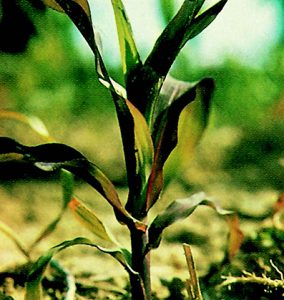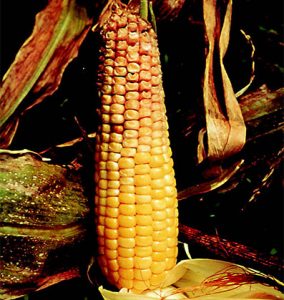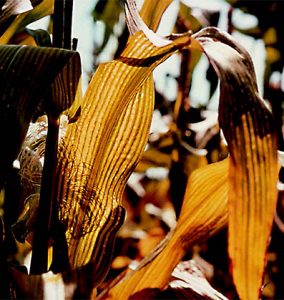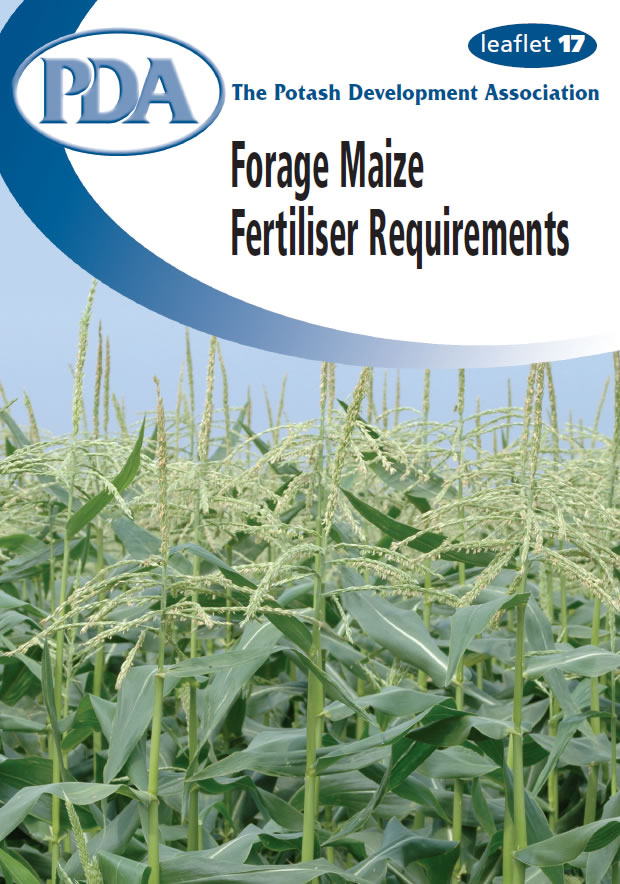Focussing on the Nutrition of Maize
May 2023
Whether grown for animal silage, AD feedstock or grain, appropriate fertilisation is vital to the success of the maize crop because it greatly influences not only the yield of the crop and its nutritional content but also growing costs.

Phosphorus
Phosphorus (P) is required particularly by the growing tips of the plant, hence its importance for root growth. Any shortage, especially in the very early stages, reduces root growth and nutrient uptake and this can adversely affect the growth of the crop for the rest of the season. Typical phosphate removal is 1.4 kg P2O5/t fresh crop – that is 55 kg/ha P2O5 for an average 40 t/ha forage crop. Typical symptoms of P deficiency (illustrated) are reddening or purpling of older leaves. These are often seen when conditions in the early part of the growing season are cold and wet, and growth is inhibited and by soil structure problems that limit the availability of soil P for root uptake.
Potash

Potash (Potassium, K) is the nutrient required in the greatest amount by maize. An average 40 t/ha crop takes up around 360 kg/ha K2O by early August. The demand for potash is particularly large in the period of rapid growth and the crop needs to take up about 8 kg/ha K2O per day. The soil must be able to supply both the total demand of 360 kg/ha and the daily requirement of 8 kg/ha without any hindrance. This requires an adequate level of readily plant available soil potassium. During maximum periods of growth, the maize plant will contain more K than N. Maize crops also remove large amounts of potash, typically 4.4 kg K2O/t fresh yield which amounts to 175 kg/ha for a 40 t/ha crop. This quantity must be replaced to maintain soil fertility. Nutrient offtake is dependent on yield; a 30 t/ha crop removes 130 kg K2O and a 50 t/ha crop removes 220 kg/ha K2O.
Potassium has several diverse roles in plants. It plays an important role in regulating the water content of the plant and with an adequate supply of K plants can survive drought stress more easily. It is essential for the transport of sugar from the leaves to the storage organs where the sugar is converted to starch. It plays a major role in maintaining the turgor (i.e. rigidity) of plant tissue. Leaves need to be turgid to remain fully extended to maximise the surface exposed to sunlight that provides the energy to convert carbon dioxide in the atmosphere to sugars in the leaves. Plants well supplied with K also seem to be less susceptible to fungal and pest attacks. Poor cob fill resulting from K deficiency is illustrated.
Magnesium

Magnesium (Mg) is an essential element in chlorophyll and hence for photosynthesis. Crop removal is 40 kg/ha MgO. The total requirement (to be supplied from manure and fertiliser) should be related to Mg level in the soil and additional Mg is only justified at soil Index 0 when 50-100 kg MgO/ha should be applied every 3-4 years. If both potash and magnesium soil levels are below the optimum, then apply the larger amount (100 kg MgO/ha). The picture illustrates typical magnesium deficiency symptoms of browning/reddening of the leaf tips and margins and pronounced yellow striping of the leaf veins.
Sulphur
Sulphur (S) is a constituent of protein together with nitrogen and the supplies of these nutrients in plants are highly inter-related. Studies have shown that one nutrient will accumulate in plants when the other is deficient, and when this deficiency is corrected the accumulated nutrient is then used in protein synthesis. Therefore, a shortage in the availability of sulphur will reduce the efficiency of nitrogen use. Sulphur deficiencies are possible in areas where the soil sulphur level is below optimum. Sulphur is applied in animal manures, but much of this is unavailable.
Trace Elements
Maize is not very sensitive to trace element deficiencies, but boron, copper, zinc, manganese and iron may occasionally be deficient on soils where manure is not applied regularly.


